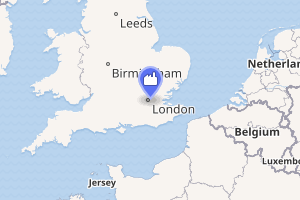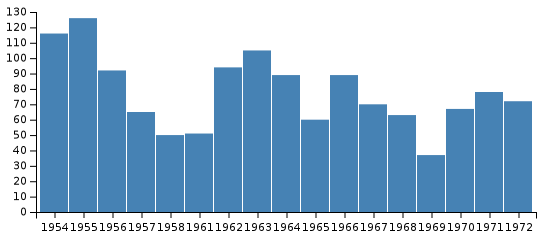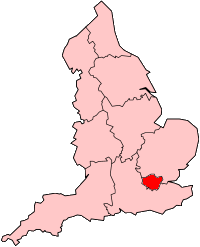Stepney Power Station
Stepney Power Station (sometimes known as Limehouse Power Station) was a small coal-fired power station situated by the Thames on the north side of Narrow Street, Limehouse, London.
| Stepney Power Station | |
|---|---|

| |
| Country | England |
| Location | Tower Hamlets, London |
| Coordinates | 51.509574°N 0.034500°W |
| Status | Decommissioned and demolished |
| Commission date | 1907 |
| Decommission date | 1972 |
| Operator(s) | Stepney Borough Council, British Electricity Authority (1948-55), Central Electricity Authority (1955-57), Central Electricity Generating Board (1958-72) |
| Thermal power station | |
| Primary fuel | Coal |
| Chimneys | 1 (351 feet) |
| Cooling source | River water |
| Power generation | |
| Units operational | 1 × 34 MW (1964-72) |
| Annual net output | see text |
grid reference TQ365808 | |
History
Stepney Borough Council began construction of the station at Blyth Wharf in 1907. A coaling jetty was built in 1923.[1] The station supplied the boroughs of Stepney and Bethnal Green.[2]
New generating equipment was added as the demand for electricity increased. The generating capacity, maximum load, and electricity generated and sold was as follows:[3][4]
| Year | Generating capacity, MW | Maximum load, MW | Electricity generated, GWh | Electricity sold, GWh |
| 1903/4 | 1.72 | 1.266 | 2.745 | 2.53 |
| 1912/3 | 8.00 | 6.046 | 17.783 | 14.580 |
| 1918/9 | 16.50 | 9.720 | 28.812 | 25.383 |
| 1919/20 | 16.00 | 10.24 | 30.836 | 28.503 |
| 1923/4 | 32.00 | 17.501 | 50.053 | 42.140 |
| 1936/7 | 70.00 | 41.904 | 95.304 | 98.686 |
| 1946 | 61.48 | 140.157 | 128.92 |
In 1923 the plant comprised one 1,500 kW, one 2,000 kW, two 5,000 kW, and one 10,000 kW turbo alternators, totalling 23,500 kW. The surplus of revenue over expenses in 1923 was £129,659.[5]
Following pollution problems from the original chimneys a single tall brick chimney was constructed in 1937,[1] dominating the area.[6] In 1956 it was reported that the first Brown-Riley coal pulveriser had been installed at Stepney power station and having been in operation for some time was working with satisfactory results.[7] At this time the equipment comprised: 1 × 34 MW Fraser & Chalmers-GEC; 1 × 19 MW Escher-Wyss-Oerlikon; 1 × 6.25 MW Escher-Wyss-Brown-Bovery; and 2 × 12.5 MW Metro-Vickers turbo-alternators.[8]
During its final decade of operation the station comprised a single 34 MW generator.[9] This was supplied with steam at a range of pressures and temperatures: 180/350 psi (12.4/24.1 bar) at 299/399/460°C. The steam capacity of the boilers was 753,000 lb/hr (94.9 kg/s).[9] The boilers comprised 3 × Stirling; 3 × Spearling; and 2 × Babcock & Wilcox.[8] Electricity output from Stepney power station was as follows.[9][10][8][11]
Stepney annual electricity output GWh.

The station continued generation until 1972 and has since been demolished. The coaling jetty in the river remains.
References
- Ellmers, Chris; Alex Warner (2000). London's Riverscape Lost and Found: Panorama of the River from 1937 and today. The London's Riverscape Lost and Found Partnership. pp. 43–44. ISBN 1-874044-30-9.
- "London Electricity Board (LEB)Pre-Vesting Undertakings (1882 - 1948) LMA/4278/01 1883 - 2003". National Archives. Retrieved 21 April 2009.
- London County Council. London Statistics (various volumes). London: London County Council.
- Electricity Commission, Generation of Electricity in Great Britain year ended 31st December 1946. London: HMSO, 1947.
- Electricity Commissioners (1925). Electricity Supply - 1920-1923. London: HMSO. pp. 86–9, 320–25.
- "Pastscapes: Stepney Power Station". Historic England. Retrieved 23 January 2020.
- "John Brown and Company Limited". The Times (page 15). 1 October 1956.
- Garrett, Frederick C. (ed) (1959). Garke's Manual of Electricity Supply. London: Electrical Press. pp. A-97, A-134.CS1 maint: extra text: authors list (link)
- CEGB Statistical Yearbook (various dates). CEGB, London.
- "British Power Stations operating at 31 December 1961". Electrical Review. 1 June 1962: 931.
- CEGB Annual Report and Accounts, various years
